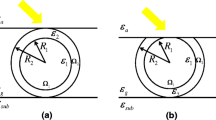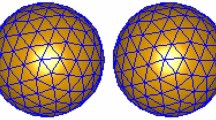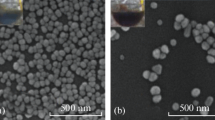Abstract
Nanosphere structures using noble metals are suitable and efficient for the development of biosensors for the detection of analytes in biological applications based on refractive index-based sensing. The nanosphere structure acts as a surface plasmon device. The gold nanospheres are commonly used as nanodevices. The modeling and analysis of the gold nanosphere structure are carried out in this work. The Mie-scattering algorithm is used to find the extinction efficiency, scattering efficiency, and absorbance efficiency of gold nanospheres, while dipole approximation methods are used as sources in the modeling of gold nanospheres with effective radii. The cross-section efficiency and sensitivity of the nanosphere-based refractive index sensor are analyzed. The mathematical analysis is conducted using the discrete dipole approximation method. The Riccati–Bessel functions are used in the Mie calculations.
















Similar content being viewed by others
References
Al Rakic AD (1995) Algorithm for the determination of intrinsic optical constants of metal films: application to aluminum. Appl Opt 34(22):4755–4767
Brullot W, Ventsislav KV, Thierry V (2012) Magnetic-plasmonic nanoparticles for the life sciences: calculated optical properties of hybrid structures. Nanomed Nanotechnol Biol Med 8(5):559–568
Butet J, Russier-Antoine I, Jonin C, Lascoux N, Benichou E, Brevet P-F (2012) Sensing with multipolar second harmonic generation from spherical metallic nanoparticles. Nano Lett 12(3):1697–1701
Chung S-Y, Chih-Yu W, Chun-Hao T, Chung-Ping C, Hung-chun C (2011) Numerical investigation of light scattering by coupled plasmonic nanospheres using a high-accuracy multidomain legendre pseudospectral time-domain method. In: 2011 XXXth URSI general assembly and scientific symposium, pp 1–4. IEEE
Cobley CM, Skrabalak SE, Campbell DJ, Xia Y (2009) Shape-controlled synthesis of silver nanoparticles for plasmonic and sensing applications. Plasmonics 4:171–179
Danilov A, Tselikov G, Wu F, Kravets VG, Ozerov I, Bedu F, Grigorenko AN, Kabashin AV (2018) Ultra-narrow surface lattice resonances in plasmonic metamaterial arrays for biosensing applications. Biosens Bioelectron 104:102–111
Du H (2004) Mie-scattering calculation. Appl Opt 43(9):1951–1956
Du H, Zhang H (2002) Ultra high precision Mie scattering calculation
Hao J, Wang J, Liu X, Padilla WJ, Zhou L, Qiu M (2010) High performance optical absorber based on a plasmonic metamaterial. Appl Phys Lett 96:251104
Jain PK, Kyeong SL, El-Sayed IH, El-Sayed MA (2006) Calculated absorption and scattering properties of gold nanoparticles of different size, shape, and composition: applications in biological imaging and biomedicine. J Phys Chem B 110(14):7238–7248
Johnson PB, Christy RW (1972) Optical constants of the nobel metals. Phys Rev B 6(12):4370
Karimi V, Babiicheva VE (2021) Mie calculations of single nanosphere cross-sections. https://nanohub.org/resources/extcs. https://doi.org/10.21981/8QEY-MN47
Kravets VG, Kabashin AV, Barnes WL, Grigorenko AN (2018) Plasmonic surface lattice resonances: a review of properties and applications. Chem Rev 118(12):5912–5951
Li G, Shen Y, Xiao G, Jin C (2015) Double-layered metal grating for high-performance refractive index sensing. Opt Express 23:8995–9003
Liao H, Nehl CL, Hafner JH (2006) Biomedical applications of plasmon resonant metal nanoparticles. Nanomedicine 1:201–208
Mayer KM, Hafner JH (2011) Localized surface plasmon resonance sensors. Chem Rev 111:3828–3857
McConnell WP, Novak JP, Brousseau LC, Fuierer RR, Tenent RC, Feldheim DL (2000) Electronic and optical properties of chemically modified metal nanoparticles and molecularly bridged nanoparticle arrays. J Phys Chem B 104(38):8925–8930
Navarrete J, Siefe C, Alcantar S, Belt M, Stucky GD, Moskovits M (2018) Merely measuring the UV–visible spectrum of gold nanoparticles can change their charge state. Nano Lett 18(2):669–674
Offermans P, Schaafsma MC, Rodriguez SR, Zhang Y, Crego-Calama M, Brongersma SH, Gomez Rivas J (2011) Universal’ scaling of the figure of merit of plasmonic sensors. ACS Nano 5:5151–5157
Sheldon MT, Van de Groep J, Brown AM, Polman A, Atwater HA (2014) Plasmoelectric potentials in metal nanostructures. Science 346(6211):828–831
Wiscombe WJ (1980) Improved Mie scattering algorithms. Appl Opt 19(9):1505–1509
Wiscombe WJ (1996) Mie scattering calculations: advances in technique and fast, vector-speed computer codes, NCAR/TN-140+STR. National Center for Atmospheric Research, Boulder
Woźniak P, Banzer P, Leuchs G (2015) Selective switching of individual multipole resonances in single dielectric nanoparticles. Laser Photonics Rev 9(2):231–240
Xu Y, Yulong F, Ye MQ, Tie JC, Dangyuan L (2022) A generalized method for calculating plasmoelectric potential in non-Mie-resonant plasmonic systems. Nanophotonics 11(11):2453–2464
Ye J, Van Dorpe P (2011) Improvement of figure of merit for gold nanobar array plasmonic sensors. Plasmonics 6:665–671
Zhang L, Uttamchandani D (1988) Optical chemical sensing employing surface plasmon resonance. Electron Lett 24:1469–1470
Zhao F, Yang W, Shih T-M, Feng S, Zhang Y, Li J, Yan J, Yang Z (2018) Plasmoelectric potential mapping of a single nanoparticle. ACS Photonics 5(9):3519–3525
Zhou Z-K, Jingfeng L, Yanjun B, Lin W, Ching EP, Xue-Hua W, Cheng-Wei Q (2019) Quantum plasmonics get applied. Prog Quantum Electron 65:1–20
Acknowledgements
We would like to thank the Management of SVIT, BMSIT&M and NMIT, Bengaluru and NIT, Silchar for supporting research culture in the institution
Author information
Authors and Affiliations
Contributions
The conceptualization of idea, methodology and design by Asha K and Suryanarayana N K; writing—original manuscript text preparation, Asha K and Suryanarayana N K; writing—review and editing done by Koushik Guha, Venkatesha M and Narayan K; supervision, project administration Suryanarayana N K.
Corresponding author
Ethics declarations
Conflict of interest
The authors declare no competing interests.
Additional information
Publisher's Note
Springer Nature remains neutral with regard to jurisdictional claims in published maps and institutional affiliations.
Rights and permissions
Springer Nature or its licensor (e.g. a society or other partner) holds exclusive rights to this article under a publishing agreement with the author(s) or other rightsholder(s); author self-archiving of the accepted manuscript version of this article is solely governed by the terms of such publishing agreement and applicable law.
About this article
Cite this article
Suryanarayana, N.K., Venkatesha, M., Asha, K. et al. Modeling and analysis of nanosphere structure for bio-sensing application. Microsyst Technol (2024). https://doi.org/10.1007/s00542-024-05680-5
Received:
Accepted:
Published:
DOI: https://doi.org/10.1007/s00542-024-05680-5




